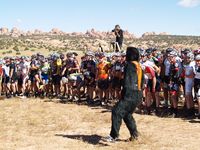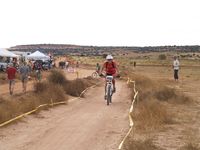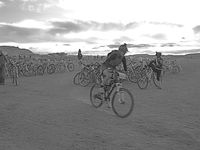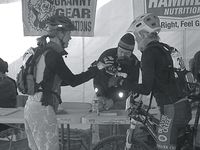14 Oct 24 Hours of Moab Bike Race: Possibilities in the Desert
By Jesse James McTigue
Moab, Utah is full of some of the most mind-boggling spectacles and seeming impossibilities. Flowers bloom among the arid, desert landscape; rock-towers spiral skyward; and delicate arches perforate smooth rock formations.
Every October, in the middle of all of this natural wonderment, an even more mind-boggling spectacle occurs – the 24 Hours of Moab mountain bike race.
 The race occurs at the end of the mountain biking season and has contenders racing from noon Saturday to noon Sunday, for 24 hours straight. Most competitors race on a four or five person team, requiring each individual rider to complete the 15-mile course three or four times. There are also competitors who compete as solo and duo riders and some of these folks do it on a single-speed—a mountain bike with one fixed gear.
The race occurs at the end of the mountain biking season and has contenders racing from noon Saturday to noon Sunday, for 24 hours straight. Most competitors race on a four or five person team, requiring each individual rider to complete the 15-mile course three or four times. There are also competitors who compete as solo and duo riders and some of these folks do it on a single-speed—a mountain bike with one fixed gear.
Every year, I am amazed at how many people are willing to subject themselves to this race (including myself). Competitors range from professional cyclists to groups of friends looking for a good time and a personal challenge. Some teams are raising money for a cause; others are just hoping to survive.
The course is very technical, meaning there are rocky ledges, rocky drops, about 1,300 feet of climbing, and fast, downhill, turns– all of which you will ride, at night. And, in the case of this year, in 25-degree weather…. at night.
For the night laps, competitors fasten lights to their handlebars and to the top of their helmets. Around the campfire, you hear a lot of chatter about how many “lums” one’s light may have. “Lums” is short for “lumens,” and the number coincides with the brightness of a light. The higher the number of “lums,” the better.
 When all the variables fall into play, the night laps can be enjoyable, even fun. But, more often than not, there is a technical problem with the lights. The batteries run out, the connection between the battery and light doesn’t work, or in my case, the attachment holding the light to the handlebars comes loose. During my night lap, when I hit a bump, which was often on the rocky, off-road, sometimes single-track course, the light swiveled upward, directly into my face, temporarily blinding me until I could slap it back down.
When all the variables fall into play, the night laps can be enjoyable, even fun. But, more often than not, there is a technical problem with the lights. The batteries run out, the connection between the battery and light doesn’t work, or in my case, the attachment holding the light to the handlebars comes loose. During my night lap, when I hit a bump, which was often on the rocky, off-road, sometimes single-track course, the light swiveled upward, directly into my face, temporarily blinding me until I could slap it back down.
I came back to camp grumbling about my light, until I heard my teammate’s story. Her light went out completely at mile three. She had forgotten to fully charge the battery. To make it around the course, she rode right behind another competitor, poaching the light from behind. These situations seem dire in the moment, but make for great stories, and become just another part of 24-hour racing.
Humor becomes an important asset for survival in such challenges and at the 24 Hours this can be seen in an occasional team costume, or more frequently in team names. Hall Pass, Chapped Stix and Heroic Mediocrity stuck out this year. Our team name was one of the announcer’s favorites, Moons Over My Chamois. Chamois is another word for bike shorts and refers to the revered built-in butt pad.
The obvious question about this race is, “Why would you ever subject yourself to such an event?” Not only subject yourself, but pay hard-earned money, during a recession, to participate?
Last weekend, during the 17th annual, 24 Hours of Moab, it seemed many alumni of the event asked themselves that very question. At the height of the race, more than 300 teams competed. This year, the numbers hovered around 217 teams. Uncertain about how to make up for the lost entry fees, Granny Gear Productions, the group who puts on the race, thinks this year may be the event’s last.
 And, as I began my fourth and last lap in the dark at 6:40 am, five-hours after having completed my previous lap at 1:40 a.m., I asked myself the same question. Since the race began at noon the day before, I had already ridden 45 miles. After four hours of sleep, I was off riding another 15-mile lap. I noticed frozen ridges in the sand, topped with a thin layer of white frost. I was cold and tired.
And, as I began my fourth and last lap in the dark at 6:40 am, five-hours after having completed my previous lap at 1:40 a.m., I asked myself the same question. Since the race began at noon the day before, I had already ridden 45 miles. After four hours of sleep, I was off riding another 15-mile lap. I noticed frozen ridges in the sand, topped with a thin layer of white frost. I was cold and tired.
I had been on edge about the race the entire week before, especially after Telluride’s early, October snow. I couldn’t get motivated and deep down, I didn’t want to do it, especially the night laps and especially for 24 hours. I had taken a pretty good crash during my second lap, hitting a rock with my head then my face. I was reminded how unforgiving and impossible the desert was. When I returned to camp, I held a cold beer against my bruised cheekbone and sat around the campfire fearing the next two laps.
A few minutes into my last lap, however, my legs felt warm and I fell into the rhythm of my cadence. I completed the first four miles, the most technical of the course, and followed the trail onto a section of smooth rock. The trail, marked by cairns, led behind three, perfectly round, boulders. I could’ve been on the moon. Passing among the gigantic rocks, I seemed to have forgotten my pre-race anxiety and even my bruised cheek.
The stars under which I began the lap had faded; the sun was coming up and the sky changed to a dark purple then light blue. I turned off my handlebar light, and the trail turned from single-track to double-track and from stone to sand. I briefly saw the sun's first rays peering over the rock cliffs in the horizon, before I descended back into the shadows. Then, I began the last climb.
As I summitted the final hill, I was blinded, but this time by the glaring rays of the rising sun; it had just crested over the horizon. There were no other competitors near me, and the day’s first light danced across the sand, making it sparkle. The desert valley below was coming alive and the surrounding sun-bleached, rock cliffs changed colors as the early light illuminated them.
For a split second, I could answer why I did this race. Then, I clicked into a higher gear and sped down the sandy descent, hoping to make up some time for my team.
 I reached the finish line and passed the baton to my teammate. “It’s beautiful,” I said. “Enjoy your last lap and have fun.” There wouldn’t be time for me to ride again; my race was done. I had ridden 60
I reached the finish line and passed the baton to my teammate. “It’s beautiful,” I said. “Enjoy your last lap and have fun.” There wouldn’t be time for me to ride again; my race was done. I had ridden 60
miles and it was 7:20 in the morning. I cracked a cold beer, maybe the same one I had used to ice my face 12 hours before.
Now that I had survived, I was at peace with the race. I hoped it would continue, but I also felt that even if this wasn’t the last 24 Hours of Moab, it might have been for me.
But, I also knew that time, just like the desert sand, can smooth away rough, rocky edges, but of memories instead of a landscape. I’m aware that, if and when the opportunity comes to register next year, the recollection of that sunrise lap will be the one to influence me, and once again I’ll be attracted to the impossibility of the race and the desert.


Sorry, the comment form is closed at this time.